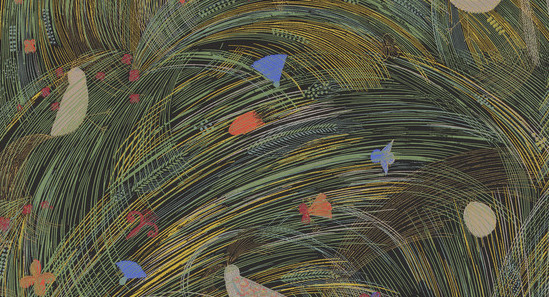This lively sidewall is the work of Felice Rix-Ueno, a designer who produced numerous textile and wallpaper patterns in the 1920s for the Wiener Werkstätte, the famous Viennese production company and artist collective formed in 1903. Her work is an excellent example of late Wiener Werkstätte designs. With the arrival of several female designers beside Rix-Ueno, including Mathilde Flogl and Maria Likarz, the Werkstatte developed a style of wallpaper centered around scattered natural forms, rendered in simple geometric shapes, with bold colors reminiscent of Art Deco. Their work was a far cry from the orderly, restrained designs seen in the earliest Werkstätte wallpapers produced by Koloman Moser and Josef Hoffmann in the first decade of the twentieth century. Similarly, the fact that this paper was machine-made represents another shift from the philosophy of these earlier designers who believed in the necessity of handmade production. The products actually created in the workshop were indeed handmade, but early on many designers from the workshop also designed products for machine manufacture by other companies. This design was made by a Swiss company named Salubra-Werke A.G that also produced color papers by Le Corbusier.
Rix-Ueno’s paper is unique from other Werkstatte examples in the way the design is centered around large whorls of green and golden grass. The style of the various birds and flowers, done in simple half-circle, clover, and triangle shapes is more commonly seen. Rix-Ueno had a strong connection with Japanese art (she married a Japanese architect Isaburo Ueno in 1925 and later moved to Japan), and perhaps the wallpaper was inspired by Japanese paintings that depicted long-bladed clumps of grass. The color scheme of gold and green and the asymmetric composition may also show the influence of Japanese art. The title Sommerfeld, like many titles of Werkstätte patterns, probably has little to do with the pattern’s inspiration but was probably applied after the design was completed. With its suggestion of a rural English countryside, it emphasizes the folksy style of the birds, flowers, and ears of wheat scattered throughout the paper. The juxtaposition of the geometric birds and the swirling grasses is both startling and quite unique for its time, but it is also what makes this paper so delightful and vibrant.
Nicholas Lopes is a student in the History of Design and Curatorial Studies graduate program at the Cooper Hewitt, and is a Master’s Fellow in the Wallcoverings Department.
